Forestry & Natural Resources
FNR 2020 Year in Review: The Research
FNR Research Breakthroughs
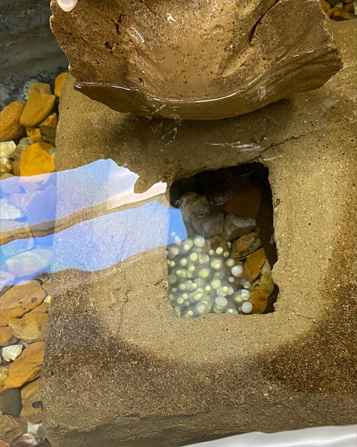 Dr. Rod Williams and his hellbender lab team were instrumental in the success of Mesker Park Zoo in getting captive hellbenders to breed naturally.
Dr. Rod Williams and his hellbender lab team were instrumental in the success of Mesker Park Zoo in getting captive hellbenders to breed naturally.The state of Indiana also selected the Eastern Hellbender project to highlight as part of the Association of Fish and Wildlife Agencies (AFWA) national effort.
Dr. Mike Saunders and researchers with the U.S. Forest Service looked at the impacts of prescribed fire on quality and economic value of lumber in a treated area.
Dr. Songlin Fei analyzed 16 years of U.S. Forest Service forestry inventory analysis regarding the impact of the emerald ash borer on the destruction of ash forests and concluded that in impacted areas, young trees are dying before they can reach their reproductive stages.
Dr. Guofan Shao’s work on map accuracy was recognized and affirmed by colleagues in “Overselling overall map accuracy misinforms about research reliability.”
Dr. Shao co-supervised a research team composed of several electrical and computer engineering (ECE) undergraduates, who have accomplished real-time measurements of tree attributes, including diameter at breast height (DBH) computation and lowest branch detection. The team successfully demonstrated the capability to automatically measure 1,000 trees in Martell Forest within 36 minutes by driving through a red oak plantation. The driving speed can be doubled or tripled when measuring a walnut plantation with clear ground conditions.
Major Grants
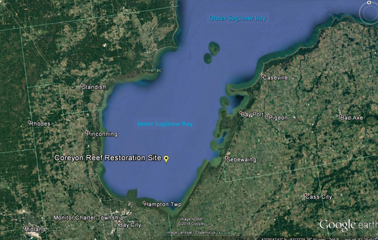 Dr. Tomas Hook and his research team will be providing a checkup on the Coreyon Reef Project in Saginaw Bay in Lake Huron through a new grant from the Michigan Department of Natural Resources and the Environmental Protection Agency.
Dr. Tomas Hook and his research team will be providing a checkup on the Coreyon Reef Project in Saginaw Bay in Lake Huron through a new grant from the Michigan Department of Natural Resources and the Environmental Protection Agency.Dr. Jacob Hosen is part of a team that will be studying how hydrology and plant community diversity can be modulated to maximize nutrient retention and minimize the production of greenhouse gasses from wetlands, after receiving a $500,000 grant from the USDA’s National Institute of Food and Agriculture (NIFA).
Dr. Bryan Pijanowski and post-doctoral research associate >Dr. Kristen Bellisario’s proposal regarding “Sensor technologies for real-time monitoring of mosquito populations through heat maps in India” was selected as one of four to receive the 2020 Shah Family Global Innovation Lab Seed Grant.
Pijanowski also received two rounds of funding from the U.S. Fish and Wildlife Service to provide bioacoustic and soundscape ecology support for the USFWS Avian Acoustic Monitoring Project.
He also is part of a multi-disciplinary effort to study the relationships Mongolian herders have with their landscapes through the lens of sound. His team of ecologists, social scientists and ethnomusicologists, received $750,000 from the National Science Foundation for the four-year project.
Dr. Linda Prokopy earned support for two new projects: “Understanding of Persistence of Cover Crop Use: Lower Wabash,” and also a social science assessment of the obstacles and opportunities for meeting nutrient management goals.
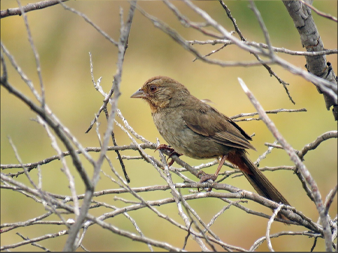 Dr. Andrew DeWoody will be studying the genetics of the Inyo California Towhee, a potentially endangered bird species.
Dr. Andrew DeWoody will be studying the genetics of the Inyo California Towhee, a potentially endangered bird species.Assistant professors Mo Zhou and Jingjing Liang will be part of a collaborative study with the University of Kentucky on “Enhancing the Awareness, Knowledge and Understanding of Sustainable Maple Syrup Production Practices Among Current and Potential Maple Syrup Producers.” The duo has been awarded a $100,000 grant from the United States Department of Agriculture - Acer Access and Development Program for their portion of the study. – Zhou, Liang Earn Maple Syrup Industry Grant
Dr. Marisol Sepulveda is part of USDA grant project working with the Florida Pompano. The study will look at “Ensuring a Steady Supply of Warm Water Marine Finfish Seed Stock to Support the Development of the U.S Aquaculture Industry. Sepulveda’s part in the research will look at developing larviculture methods for sustainable production of high- value water marine finfish, specifically evaluating the transcriptome response of Florida Pompano to differences in salinity.
Dr. Liz Flaherty is part of a newly funded grant from the National Science Foundation: “Collaborative Research: The Ecological Basis of Hunting and Meat Sharing in Female Savanna Chimpanzees,” an interdisciplinary project, which assesses female biased hunting. It is part of the HUNTRESS (hunting, nutrition, tool use, reproductive ecology, and meat sharing in savanna chimpanzees) project. Flaherty will be leading the stable isotope component of the project.
Dr. Stuart Carlton, assistant director of the Illinois-Indiana Sea Grant program, clinical engagement professor Dr. Kwamena Quagrainie and clinical assistant professor Dr. Mitch Zischke received rapid- response funding from the National Sea Grant Office to assess the impacts of COVID-19 on aquaculture and charter fisheries in Illinois and Indiana.
Collaborations
FNR teamed up with Conservation Leaders for Tomorrow and the Max McGraw Foundation to develop a new online course “Hunting for Conservation” that looks at the cultural, biological, economic and policy aspects of hunting: New online course from Purdue focuses on hunting’s role in wildlife management and conservation and Purdue Partners with CLfT for Online Conservation Offerings.
FNR and the Indiana Department of Natural Resources introduced a video series for woodland owners, which will help educate landowners on options for managing their woodlands.
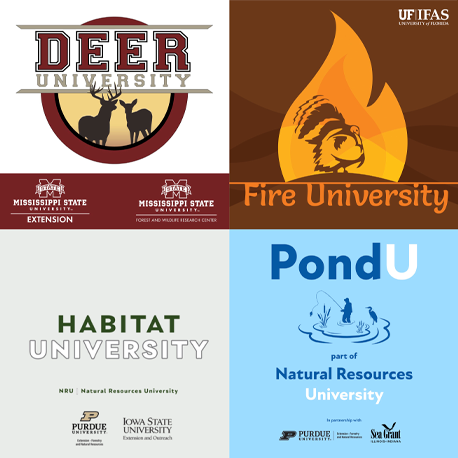 Dr. Mitch Zischke, Purdue Extension wildlife specialist Jarred Brooke and recruitment and outreach specialist Megan Gunn began producing a pair of podcasts, part of a national network called the Natural Resources University. Zischke and Gunn are co-hosts of the Pond University podcast, while Brooke co-hosts the Habitat University podcast with Adam Janke, extension wildlife specialist at Iowa State University.
Dr. Mitch Zischke, Purdue Extension wildlife specialist Jarred Brooke and recruitment and outreach specialist Megan Gunn began producing a pair of podcasts, part of a national network called the Natural Resources University. Zischke and Gunn are co-hosts of the Pond University podcast, while Brooke co-hosts the Habitat University podcast with Adam Janke, extension wildlife specialist at Iowa State University.Chelsea Silva developed a workshop series “Coexistence” providing introductory human subjects training in Spanish as part of the Arequipa Nexus group.
Dr. Elizabeth Flaherty teamed up with researchers across the country to create Squirrel Net, a unique set of teaching modules to educate on biodiversity.
The Integrated Deer Management Project’s RMU Research Techniques were adopted by the Indiana Department of Natural Resources. The DNR turned the research, conducted by Dr. Rob Swihart, Jarred Brooke and Dr. Zhao Ma, from research management units into deer management units with slight modifications. The IDMP’s research and collaboration with the Indiana Division of Fish and Wildlife is mentioned here: Integrated Deer Management Project Website Introduced
Drs. Songlin Fei and Brady Hardiman and postdoctoral associate Elizabeth LaRue put together a virtual Forest Diversity Workshop, focusing on how structural diversity describes the combination of structure and biodiversity within complex ecosystems, and how this is related to forest ecology.
FNR in the Media
Deforestation drove massive Amazon rainforest fires of 2019 highlighted the work of an assistant professor of quantitative ecology Jingjing Liang and his team, which used remote sensing platforms to understand the relationship between land cover and the 2019 fires.
Remote Sensing Gives New Look at Forest Diversity featured the work of Dr. John Couture, which used aerial hyperspectral remote sensing platform to identify trees in a diverse forest plantation and to understand the role of tree diversity on forest productivity.

Recruitment and outreach specialist Megan Gunn was included in a story about creative ways to reach students during the COVID-19 pandemic.
Dr. Jingjing Liang utilized big data and machine learning to show how tree planting efforts in South Korean forests and one in northeast China are increasing carbon storage.
Undergraduate students Tabitha Olsen and Helen Nesius were
recognized for their commitment to continuing
research on the northern saw-whet owl.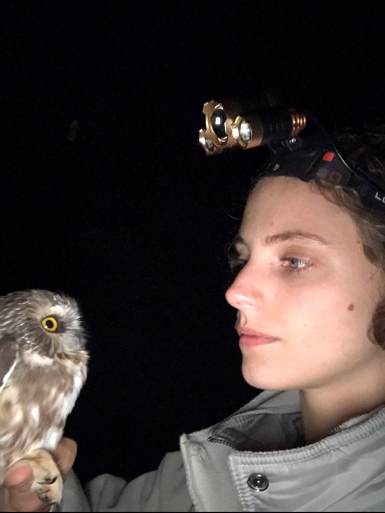
recognized for their commitment to continuing
research on the northern saw-whet owl.

Graduate students working in conjunction with Dr. Paul Brown, Hye-Ji Kim, assistant professor of horticulture and landscape architecture, and Jen-Yi Huang, assessed the environmental and economic impacts of both hydroponics and aquaponics.
Alumnus Mark Smith shared about how his company, Great Lakes Forest Products, was affected by the COVID-19 pandemic.
Dr. Doug Jacobs and the Hardwood Tree Improvement and Regeneration Center’s work with industry partners and the National Science Foundation were highlighted in the article “Purdue Pursues Industry Hardwood Partnerships through NSF-Backed Center.”
Alumna Skye Greenler shared about her experiences in the Oregon wildfires as well as her recently published research on prescribed fire.
Dr. Rod Williams and Nick Burgmeier talk about their involvement with hellbender research and rearing and with Mesker Park Zoo’s 2020 captive breeding success in this article “Eastern Hellbender, a Sentinel of Water Quality, Bred in Captivity for First Time, at Evansville Zoo", in the Herald Bulletin.
Pat McGovern, project coordinator of the Integrate Deer Management Project, and his past jobs, including one tracking mountain lions, were featured here “How one FNR Research Coordinates Observation of Indiana’s Deer Population.”
Dr. Jeff Dukes, Director of the Purdue Climate Change Research Center, wrote two opinion/editorial pieces on his experience as part of the Climate-Related Market Risk Subcommittee for the U.S. Commodity Futures Trading Commission. “Most surprising thing about a new report showing climate changes imperils the US financial system is that the report even exists” in The Conversation and “How climate change threatens the U.S. financial system” in the Chicago Tribune.
Dr. Bryan Pijanowski, director of the Center for Global Soundscapes was part of a video series by The Cube, regarding the importance of sound in assessing the health of the planet.
Dr. Songlin Fei, winner of the 2020 Agricultural Research Award, was featured in “From Farm to Forest, Songlin Fei Has Built a Career and Better Life”
Megan Gunn was featured by Black in Science Communication as part of Black in Science Communication week.
The U.S. Forest Service’s Shaneka Lawson, whose lab is located in Pfendler Hall, had her work on Improving Growth of Black Walnut featured in the Northern Research Station newsletter.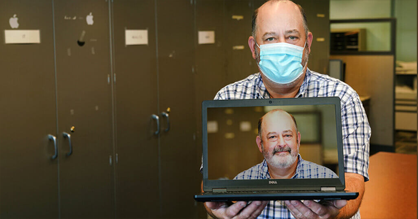

Computer analyst Richard Fox’s work in the College of Agriculture was featured in Behind the Research: Richard Fox.
Dr. Elizabeth Flaherty talks about black bears, an unexpected animal of Indiana.
Urban forester Lindsey Purcell’s expertise on trees near powerlines in wildfire zones was shared by Voice of San Diego in the article “Regulators Approve SDG&E Wildfire Plan Despite Serious Flaw.”
Dr. Songlin Fei’s work on emerald ash borer destruction was featured in the article “Sparking Beetle Could Spell Doom for North America’s Ash Trees” in Science Magazine.
Dr. Jeff Dukes spoke on WBEZ Radio in Chicago about “How Climate Change Threatens the U.S. Financial System.” He also talked about how just a few degrees of climate change can have widespread consequences on Big Picture Science in October. Dukes was quoted in the Washington Post article “What the Coronavirus Can Teach Us about Fighting Climate Change,” in August. Dukes also shared about environmental issues in a video panel for the Indianapolis Star – “Environmental Issues Loom Large in 2020 Election.”
Dr. Mike Saunders talked about the use of prescribed fire to manage forest lands in the Indiana Woodland Steward.
Drs. Jason Hoverman and Dr. Marisol Sepulveda’s work on “forever chemicals” was featured in the article “Purdue Group Prominent in Studying Chemical Compounds That Are Everywhere and Shouldn’t Be.”
Dr. Bryan Pijanowski spoke about his experiences internationally as part of the International Research Reflections session.
Dr. Jingjing Liang spoke about the impact of the COVID-19 Pandemic on deforestation and climate change, as well as the global forest biodiversity initiative on South Korean Public Radio Station TBS eFM.
Here’s a tribute to FNR alumnus Scott Brundage, a past member of our FNR external advisory committee that passed away.
Dr. Jingjing Liang shares about the need for international collaboration and data sharing in the article “COVID Lessons Applied to Forestry, Climate Change.”
Dr. Linda Prokopy explained how ag systems are impacted by climate change & offered a list of 20 indicators that provide a broad look at what's happening across the country in “Report Provides New Framework for Understanding Climate Risks, Impacts to US Agriculture.”
Dr. Prokopy was interviewed on NPR about the effects of renting land on farmer’s environmental practices.
Dr. Bryan Pijanowski spoke about the rhythmic natural of animals and the soundscape on Grist.org in These Scientists are Using Machine Learning to Listen to Nature (Literally).
Dr. John Couture conducted critical research and trying to keep things alive during the COVID-19 shutdown. His work is featured in “Plant Scientists Maintain Critical Research to Save Data and Irreplaceable Plants.”

Alumna Jessica Outcalt offered backyard birdwatching tips in “Backyard Birding, Tips to Attract Birds to Your Nest.”
Master’s degree alumnus Ben Leonhardt and Dr. Tomas Hook’s lab’s work on “Lake Michigan Chinook Salmon Stick with Declining Alewife as Their Main Meal,” was featured by Illinois-Indiana Sea Grant.
Senior Grace Walker’s summer internship with the Muncie Bureau of Water Quality was highlighted in this FNR Field Report.
Megan Gunn talked about her experiences during work trips to the middle of nowhere to do research collections with WJCT All in Indiana in Hiking While Black. Gunn also was highlighted by Indiana Public Media during Black Birders Week.
WLFI reported on the efforts to rid the local area of the invasive Bradford pear, including quotes from urban forestry specialist Lindsey Purcell.
The field research of Dr. Liz Flaherty and Dr. Zhao Ma were featured in “So You Want to Do Field Research.”
Undergraduate Rachel Brummet’s journey to Purdue FNR through a chance encounter with Dr. Liz Flaherty was featured in “Wildlife and Forestry Student Branches Out.”
Graduate student Laura Jessup’s adventure in being trapped in Peru amidst COVID-19 travel bans was featured in several stories. Jessup was part of stories in the Lansing State Journal – DeWitt native trapped in Peru during COVID-19: Lockdown not Ideal but ‘for the greater good’, the Lafayette Journal and Courier, and by the College of Agriculture: FNR student demonstrates perseverance and perspective.
Research by David Savage, Dr. Kristen Bellisario and Dr. Bryan Pijanowski takes a look at the impact of stay and home orders on the global environment.
Field research coordinator Emily Mettler passed away in March. A celebration of her life, research and career is available here.
The adjustments that Purdue Extension wildlife specialist Jarred Brooke made for his fire ecology class are featured in “When Best Laid Plans Go Up in Smoke.”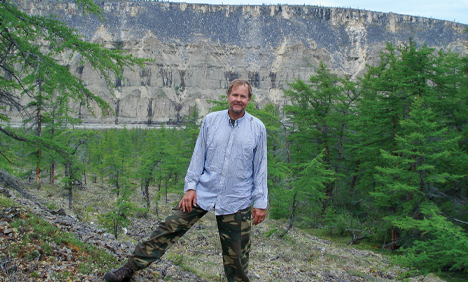

1979 forestry alum Ross Nelson turned his ability to interpret satellite data and turn it into maps into a NASA job looking back at Earth’s forests and map how they change over time. Learn more in Space Scientists.
Dr. Zhao Ma surveyed northwest Indiana residents to learn what can motivate them to adopt conservation practices.
Master’s degree student Ashley Archer was recognized by the Purdue Native American Educational and Cultural Center.
Master’s degree student Maggie Wigren’s work was featured by the Gulf of Mexico Research Initiative in an article called “Grad Student Wigren Shows It Takes Guts to Explore How Oil Affects Fish’s Microbiomes."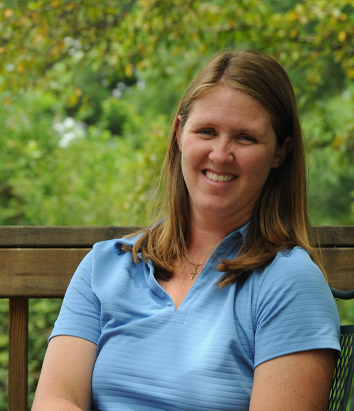

Alumna Amanda Wuestefeld was featured in the Indianapolis Star after being named the Director of Fish and Wildlife for the Indiana Department of Natural Resources.
The Tipping Point Planner Team’s work creating science-based tools to assist with planning decisions related to water quality was highlighted in “With GIS, Communities See How Land-Use Changes May Affect Local Water Quality.”
Senior Kellee Edington was featured in Competitive Spirit Helps Chop Down Barriers.
Alumna Mary Beth Adams’ career in forestry was featured in The Forestry Source.
Master’s degree student Zachary Finn wrote “Restore prairie on your property to protect history, wildlife and humanity” for The Woodland Steward 29 (2): 8-9, 14.
FNR Presentations
Extension forester Ron Rathfon presented “Prescribed Grazing for Managing Invasive Woody Vegetation in Eastern Hardwood Forests,” at the 2020 Upper Midwest Invasive Species Conference in November.
Dr. Rob Swihart and Dr. Pat Zollner presented their research on bobcat (Lynx rufus) recovery in south-central Indiana: survival, home range sizes, and habitat selection at the Indiana Wildlife Federation Conference in Indianapolis in February.
Dr. Rob Swihart, Pat McGovern and Z.D. Delisle presented on using cameras to focus wildlife management: advances in data acquisition and analysis, to the Indiana Chapter of The Wildlife Society at Spring Mill State Park in February. Swihart and master’s degree alumna Megan Zagorski also presented on “Improving raptor habitat in agroecosystems of west-central Indiana: the importance of cover crops and artificial perches,” at the event.
Swihart also presented project updates on small mammals and mast at the Hardwood Ecosystem Experiment annual researcher meeting.
Urban forester Lindsey Purcell presented on Tree Pruning Essentials at the Indiana Arborist Association convention in January. He gave a presentation on urban forestry at Stephen F. Austin in February. He also spoke on topics ranging from pruning to disease and decay to tree appraisal at 10 webinars throughout the year. He then presented on “Pruning for Performance and Prevention” at the Illinois Arborist Association annual meeting in December and on “Tree Decline in Urban Landscapes” as part of the Taking Root Seminar in Cincinnati, Ohio, in December.
Purdue Extension forester Lenny Farlee, wildlife specialist Jarred Brooke and recent PhD alumna Jessica Outcalt spoke at the Indiana Woodland Owners Conference in November. Farlee discussed Limiting Property Carrying Costs and Tax Liability, while Brooke and Outcalt spoke about wildlife habitat management and songbirds and bird habitat respectively.
Farlee presented on invasive plant species management at the Indiana Cooperative Invasive Species Management Areas Conference. He also spoke on both tax considerations for woodland owners and open questions and on economic and technical assistance available to woodland owners at the Walnut Council annual meeting and as part of the organization’s landowner online education series.
 Undergraduates Emilie Washer and Angela Guo with mentorship from Chelsea Silva presented a poster on Private Nursery Seeding Production in the Midwestern and Eastern U.S. at the Purdue Office of Undergraduate Research Fall Expo Conference.
Undergraduates Emilie Washer and Angela Guo with mentorship from Chelsea Silva presented a poster on Private Nursery Seeding Production in the Midwestern and Eastern U.S. at the Purdue Office of Undergraduate Research Fall Expo Conference.Dr. Zhao Ma presented with alumna Myesha Clarke and Kristin Floress about factors that may influence absentee forest owners to become more active land managers at the Society of American Foresters Conference in October.
Brooke McWherter, a PhD student in Dr. Zhao Ma’s lab, was part of an Ask a Scientist podcast talking about social science, how they measure people’s thoughts and what can drive wildlife conflict.
Dr. Linda Prokopy participated in a discussion on holistic approaches to urban and agricultural nutrient management issues, presented by The Water Research Foundation.
Several FNR students, past and present, presented at the American Fisheries Society virtual convention in September, including master’s student Josh Tellier “Using 3-Dimensional Models of Growth-Rate Potential to Estimate Available Fish Habitat in the Central Basin of Lake Erie,” master’s student Claire Schraidt “Population Connectivity and Local Adaptation in Lake Michigan Yellow Perch" and PhD candidate Avril Harder “Predicting Adaptive Responses to Selection in a Threatened Fish."
Purdue Extension wildlife specialist Jarred Brooke, Hellbender Husbandry Lab Coordinator Shelby Royal, aquatic ecology lab manager and undergraduate student recruiter Megan Gunn and graduate student Nerisa Ve’e-Taua spoke as part of the Tippecanoe County Partnership for Water Quality Virtual Conservation LIVE series.
Drs. Eva Haviarova and Rado Gazo and Dan Bollock presented at the Indiana Hardwood Lumbermen’s Association convention in Indianapolis in February.
Master’s degree student Aishwarya Chandrasekaran’s research with remote sensing, image processing, forest metrics and machine learning was featured in the Purdue Graduate Ag Spotlight.
Dr. Guofan Shao gave a presentation titled “Automated Image Processing in Forest Inventory Works Faster and Better than Humans,” at the Virtual Purdue Summer Undergraduate Research Symposium in August.
Extension forester Ron Rathfon presented a paper entitled “Prescribed Grazing for Managing Invasive Woody Vegetation in Eastern Hardwood Forests” at the 2020 Upper Midwest Invasive Species Conference, which took place virtually in November.
PhD candidate Rebekah Dickens Ohara shared an hour-long presentation with the Hawai’i Experimental Tropical Forestry (HETF), titled “Community-Managed Forests in Hawaii: Exploring Pathways and Opportunities.” She also spoke about her research exploring opportunities for community-managed forests in Hawai’i at the Hawai’i Conservation Conference in September. Dickens Ohara also presented a guest lecture on community-managed forests to a high school audience through the Headwaters Science Institute.
Dr. Jeff Dukes gave several presentations throughout the year, including one on Climate Change in Indiana: Engineering for a New Future,” which he shared with the American Council of Engineering Companies of Indiana and the Metropolitan Planning Organization. He also spoke on “Potential for natural carbon storage in Indiana Farmland and forest” in front of the Agriculture and Natural Resources Committee of the Indiana State Legislature, and on “Implications of Climate Change for Indiana” to the Rural Caucus of the Indiana State Legislature.
Dr. Jason Hoverman gave a presentation entitled “Quantifying the Distribution, Movement and Ecological Risk of PFAS in an Impacted Wetland System” to the Michigan Department of Natural Resources. He also presented on “The relative toxicities of current use aqueous film forming foams and next generation alternatives to aquatic species for informing risk assessments at the Department of Defense SERDP/ESTCP Symposium.
Dr. Marisol Sepulveda presented on “Per-/polyfluoroalkyl substance mixture in toxicity of amphibians” at the Department of Defense SERDP/ESTCP Symposium.
Dr. Barny Dunning spoke on Climate Change and Wildlife at the Indiana Wildlife Federation annual meeting. He also participated in a Strategies of Online Teaching discussion to assist fellow Purdue faculty and staff members during the COVID-19 pandemic in June 2020.
FNR Outreach/Extension Efforts
The FNR Extension staff moved from in-person gatherings to a fully-online format, but that did not stop the development of content and dissemination of information.
FNR Extension specialists put together 20 publications on a variety of topics and also developed several new video series and webinars to help spread the word about a variety of woodland and wildlife-related topics.
All told, the FNR extension produced 90 videos which were viewed nearly 90,000 times on the FNR website,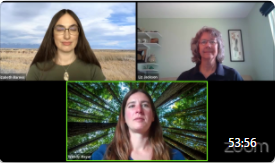 social media and YouTube.
social media and YouTube.
 social media and YouTube.
social media and YouTube.The Ask the Expert Facebook Live question and answer series covered a variety of topics in its 26 episodes, from hellbenders and pollinators to tree inspections to woodland pests and invasive species.
Several extension specialists brought the outdoors to the people through new video series.
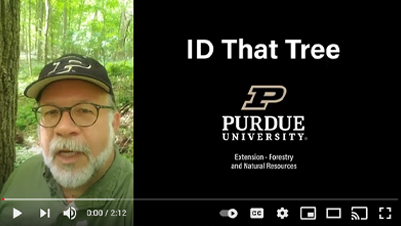 Extension forester Lenny Farlee introduced the ID That Tree and Woodland Management Moment series, featuring native Indiana trees and a variety of woodland management topics respectively.
Extension forester Lenny Farlee introduced the ID That Tree and Woodland Management Moment series, featuring native Indiana trees and a variety of woodland management topics respectively.- Extension wildlife specialist Jarred Brooke covered native grasses, food plots and prescribed fire in his Wildlife Habitat Hint series.
- Dr. Rod Williams and extension wildlife specialist Nick Burgmeier spoke about snakes, hellbenders and habitat issues in the A Moment in the Wild.
- The Woodland Stewardship for Landowners series, a joint effort with the Indiana Department of Natural Resources, presented information about invasive species, forest management, and more.
- The Hardwood Ecosystem Experiment shared videos about the management techniques being administered on the HEE properties as well as about the variety of wildlife species found on the HEE.
- Urban forester Lindsey Purcell spoke about common tree planting problems, while wildlife specialist Brian MacGowan helped landowners protect their flowerpots as well as their trees and shrubs from wildlife damage.
Extension Publications
- Transporting Food Waste – Dr. Rod Williams
- The Nature of Teaching: Ecotoxicology and Environmental Health – Dr. Rod Williams and Dr. Jason Hoverman
- The Nature of Teaching: Disease Ecology – Dr. Rod Williams and Dr. Jason Hoverman
- The Nature of Teaching: Resourceful Animal Relationship – Dr. Rod Williams
- Tree Defect Identification – urban forester Lindsey Purcell
- Surface Root Syndrome – urban forester Lindsey Purcell
- Sustainable Aquaculture: What does it mean to you? - Amy Shambach, aquaculture marketing outreach specialist
- Walleye Farmed Fish Fact Sheet: A Guide for Seafood Consumers – Amy Shambach, aquaculture marketing outreach specialist
- Best Practices Guide for Charter Fishing and COVID-19 – Dr. Mitch Zischke
- A Pond Management Plan Template – Dr. Mitch Zischke
- Pond Management: Managing Fish Populations – Dr. Mitch Zischke
- Managing Your Woods for White-Tailed Deer – Extension wildlife specialists Jarred Brooke and Dr. Mitch Zischke
- No Room at the Inn: Suburban Backyards and Migratory Birds – Master’s degree alumna Jessica Outcalt and Dr. Barny Dunning
- iListen.org Guide: Skills and Missions – Dr. Bryan Pijanowski, Director of the Center for Global Soundscapes
- Community Soundscape Planning Guide: Controlling Noise and Protecting Natural and Cultural Sonic Spaces – Dr. Bryan Pijanowski, Director of the Center for Global Soundscapes, and Kara Salazar, assistant program leader and extension specialist for sustainable communities.
- Your Ecosystem Listening Labs (YELLS): The Science of Soundscape Ecology Instructor’s Guide, Grades 5- 8 – Dr. Bryan Pijanowski, Director of the Center for Global Soundscapes
- Tipping Points: What are they? Why are they important? - Kara Salazar, assistant program leader and extension specialist for sustainable communities.
- Informing the Development of the Great Lakes Region Decision Support System – Dr. Bryan Pijanowski, professor of landscape and soundscape ecology.
FNR Publications
- Differing, multi-scale landscape effects on genetic diversity and differentiation in eastern chipmunks. Undergraduate Elizabeth Kierepka, Dr. Rob Swihart. 2020. Heredity, in press
- Palatability of common cover crops to voles (Microtus). Graduate student Abby-Gayle Prieur and Dr. Rob Swihart. 2020. Crop Protection, in press.
- A novel bioaugmentation technique effectively increases the skin-associated microbial diversity of captive eastern hellbenders – Dr. Rod Williams in Conservation Physiology, Volume 8, Issue 1
- Prescribed fire promotes acorn survival and seedling emergence from simulated caches. Graduate students Skye Greenler, Dr. Rob Swihart, and Dr. Mike Saunders. 2020. Forest Ecology and Management, in press.
- Silviculture at establishment of hardwood plantations is relatively ineffective in the presence of deer browsing. MS alumnus Caleb Redick, Don Carlson, Dr. Mike Jenkins, Dr. Doug Jacobs. Forest Ecology and Management, Volume 474, October 15, 2020, 118339.
- Mitigation of Deer Herbivory in Temperate Hardwood Forest Regeneration: A Meta-Analysis of Research Literature. MS alumnus Caleb Redick, Dr. Doug Jacobs; Forests 11, 1220.
- The urgency of transforming the Midwestern U.S. landscape into more than corn and soybean – Dr. Linda Prokopy in Agriculture and Human Values, Volume 37, pages 537-539
- Population-Level Variation in Neonicotinoid Tolerance in Nymphs of the Heptageniidae – Dr. Jason Hoverman, graduate student D. Riley Rackliffe in Environmental Pollution, Volume 265, Part B, Oct. 2020
- Source Switching Maintains Dissolved Organic Matter Chemostasis across Discharge Levels is in a Large Temperate River Network – Dr. Jacob Hosen in Ecosystems 2020
- Diet complexity of Lake Michigan salmonines: 2015–2016 – MS alumnus Ben Leonhardt in Journal of Great Lakes Research, Volume 46, Issue 4, Pages 1044-1057
- Communication, Partnerships, and the Role of Social Science: Conservation Delivery in a Brave New World – Linda Prokopy in Society and Natural Resources, Volume 33, Issue 7
- Seed propagation protocol for pure and hybrid butternut – doctoral candidate Andrea Brennan, Doug Jacobs in Reforestation, Nurseries and Genetics Resources
- Timing and order of exposure to two echinistome species affect patterns of infection in larval amphibians – master’s alumnus Logan Billet, Journal of Parasitology
- Prescribed fire does more good than harm when managing forests on public lands – Dr. Mike Saunders in the Indiana Woodland Steward
- A Flexible Model‐based Approach to Delineate Wildlife Management Units – Rob Swihart, Jarred Brooke, Zhao Ma in Wildlife Society Bulletin, Volume 44, Issue 1
- Behavioral constraints on local adaptation and counter‐gradient variation: Implications for climate change – doctoral student Brandon Quinby in Ecology and Evolution, Volume 10, Issue 13
- No acclimation: instantaneous responses to temperature maintain homeostatic photosynthetic rates under experimental warming across a precipitation gradient in Ulmus Americana – Dr. Jeff Dukes in AoB Plants, Volume 12, Issue 4
- Identifying the commons ground: Small-scale farmer identity and community – Dr. Zhao Ma, Anna Erwin, Keri Iles in the Journal of Rural Studies, Volume 78, pages 25-35
- Differential habitat use patterns of yellow perch Perca flavescens in eastern Lake Michigan and connected drowned river mouth lakes - Master’s student Taylor Senegal, Dr. Tomas Hook in Journal of Great Lakes Research
- Comparative Life Cycle Assessment of Aquaponics and Hydroponics in the Midwestern US – graduate research assistant Peng Chen, Dr. Paul Brown in Journal of Cleaner Production, Volume 275
- The practice of Payments for Ecosystem Services (PES) in the Tropical Andes: Evidence from program administrators – Dr. Zhao Ma in Ecosystem Services, Volume 45
- Individual-based modeling highlights the importance of mortality and landscape structure in measures of functional connectivity – Dr. Pat Zollner, Casey C. Day, Nicholas P. McCann in Landscape Ecology
- Stable isotope ecology in insects: a review – PhD student Brandon Quinby, Dr. Elizabeth Flaherty in Ecological Entomology
- Crop insurance: A barrier to conservation adoption – Dr. Linda Prokopy, Jackie Getson in Journal of Environmental Management, Volume 276, December 2020
- Squirrel-Net Teaching Modules Published on CourseSource – Dr. Elizabeth Flaherty is part of a series of publications released on Sept. 14 related to squirrel and other rodent behavior.
- Source Switching Maintains Dissolved Organic Matter Chemostasis Across Discharge Levels in a Large Temperate River Network – Dr. Jacob Hosen in Ecosystems
- Mechanisms underlying detection of seed dormancy by a scatter-hoarding rodent. Graduate student Mekala Sundaram, undergraduate Ashley Higdon, Dr. Rob Swihart in Integrative Zoology 15:89-102.
- Field attributes and farming practices associated with vole (Microtus) damage in cover-cropped fields. Graduate student Abby-Gayle Prieur and Dr. Rob Swihart. 2020. Agriculture, Ecosystems, and Environment, in press.
- Are Northern harriers (Circus hudsonius) are facultative specialists on arvicoline rodents in midwestern agroecosystems. Graduate student Megan Zagorski, and Dr. Rob Swihart. 2020. American Midland Naturalist 184:188-204, October 2020.
- Survival and mortality sources in a recovering population of bobcats (Lynx rufus) in south-central Indiana. Postdoctoral researcher L.R. Jones, undergraduate student E. Godollei, S.A. Johnson, C.M. Hudson, Dr. Pat Zollner, and Dr. Rob Swihart. 2020. American Midland Naturalist, in press.
- Killing time in cover crops? Artificial perches promote field use by raptors. Graduate student Megan Zagorski, and Dr. Rob Swihart. 2020. Annals of Applied Biology, in press.
- Reduced overwinter survival of waste corn (Zea mays) in fields with cover crops. Graduate student Abby-Gayle Prieur, undergraduate alumna Alexis L. (Vercauteren) Kosins, Dr. Rob Swihart; Weed Biology and Management 20:147-153; 2020
- Estimating Population Abundance of Burying Beetles Using Photo Identification and Mark-Recapture Methods. PhD Brandon Quinby, Dr. Elizabeth Flaherty; Environmental Entomology, nvaa139; Nov. 28, 2020.
- Impacts of COVID-19 on Ecology and Evolutionary Biology Faculty in the United States. Dr. Zhao Ma; Ecological Applications. Nov. 23, 2020.
- Outsourcing Governance in Peru’s Integrated Water Resources Management. Post doctoral research associates Ruxandra Popovici and Anna Erwin, Dr. Zhao Ma, Dr. Linda Prokopy. Science Direct.
- Multi-Dimensional Motivations and Experiences of Small-Scale Farmers. Keri Iles, Rebecca Nixon, Dr. Zhao Ma; Society of Natural Resources. Oct. 4, 2020.
- Demographic Analysis of Invasible Habitat Fraction Identifies Context-Dependent Roles of Resource Availability and Biotic Resistance in Determining Invasion Success. Dr. Jeff Dukes. Journal of Ecology, Sept. 16, 2020.
- Effects of Polycyclic Aromatic Hydrocarbons and Abiotic Stressors on Fundulus grandis Cardiac Transcriptomics. Elizabeth Allmon, Jennifer Serafin, Shuai Chen and Dr. Marisol Sepulveda. Science of the Total Environment, Jan. 15, 2021.
- Timing and Order of Exposure to Two Echinostome Species Affect Patterns of Infection in Larval Amphibians. Master’s degree alumnus Logan Billet, Dr. Jason Hoverman; Parasitology, Volume 147, Issue 13; August 2020.
- Reviews and Syntheses: Soil Responses to Manipulated Precipitation Changes – an Assessment of Meta-Analyses. Master’s student Akane Abbasi, doctoral student Maria del Rosario Uribe and Dr. Jeff Dukes; Biogeosciences, 17, 3859-3873; 2020.
- Late-Spring Frost Risk Between 1959 and 2017 Decreased in North America But Increased in Europe and Asia. Dr. Jingjing Liang. Proceedings of the National Academy of Sciences of the United States of America (PNAS); May 11, 2020.
- Population-level variation in neonicotinoid tolerance in nymphs of the Heptageniidae. Graduate research assistant D. Riley Rackliffe and Dr. Jason Hoverman; Environmental Pollution, Volume 265, Part B; October 2020.
- National Print Media vs. Agricultural Trade Publications: Communicating the 2012 Midwestern US Drought. Former research assistant Sarah Church and Dr. Linda Prokopy. Climate Change, 161, 43-63 (2020).
- Silviculture at Establishment of Hardwood Plantations is Relatively Ineffective in the Presence of Deer Browsing. Graduate student Caleb Redick, Don Carlson, Dr. Mike Jenkins, Dr. Doug Jacobs; Forest Ecology and Management 474, 118339.
- Mitigation of Deer Herbivory in Temperate Hardwood Forest Regeneration: A Meta- Analysis of Research Literature. Graduate student Caleb Redick, Dr. Doug Jacobs; Forests 11, 1220; November 19, 2020.
- An Assessment of the Potential Impacts of Climate Change on Freshwater Habitats and Biota of Indiana, USA. Dr. Tomas Hook, Caroline Foley, Dr. Paris Collingsworth, Dr. Jason Hoverman, Dr. Elizabeth LaRue; Climate Change, 163, 1897-1916; 2020.
- Chronic Per-/Polyfluoroalkyl Substance Exposure Under Environmentally Relevant Conditions Delays Development in Northern Leopard Frog (Rana Pipiens) Larvae. R. Wesley Flynn, Michael Iacchetta, Dr. Marisol Sepulveda, Dr. Jason Hoverman; Society of Environmental Toxicology and Chemistry; Feb. 18, 2020.
- Conservation decisions under pressure: Lessons from an exercise in rapid response to wildlife disease. Dr. Jason Hoverman; Conservation Science and Practice, Volume 2, Issue 1/ ee141; Nov. 29, 2019.
- Consistent effects of pesticides on community structure and ecosystem function in freshwater systems. Dr. Jason Hoverman; Nature Communications, 11, Article number 6333; December 10, 2020.
- Dynamic spatiotemporal patterns of metapopulation occupancy in patchy habitats. Dr. Jason Hoverman; Royal Society Open Science, 2020.
- Perfluoroalkyl substances increase susceptibility of northern leopard frog tadpoles to trematode infection. Sophia R. Brown, R. Wesley Flynn, Dr. Jason Hoverman; Environmental Chem., Jan. 29, 2020.
- Pesticide tolerance induced by a generalized stress response in wood frogs (Rana sylvatica). Master’s alumnus Logan Billet, Dr. Jason Hoverman; Ecotoxicology, 29(9), 1476-1485; Sept. 16, 2020.
- Predator- and competitor-induced responses in amphibian populations that evolved different levels of pesticide tolerance. Dr. Jason Hoverman; Ecological Applications; https://www.ncbi.nlm.nih.gov/pmc/articles/PMC3804236/
- Relative acute toxicity of three per- and polyfluoroalkyl substances on nine species of larval amphibians. Megan Gannon; Dr. Marisol Sepulveda, Dr. Jason Hoverman; Society of Environmental Toxicology and Chemistry.
- Single and mixture per- and polyfluoroalkyl substances accumulate in developing Northern leopard frog brains and produce complex neurotransmission alterations. Dr. Jason Hoverman, Dr. Marisol Sepulveda, T.D. Hoskins, R. Wesley Flynn; Neurotoxicology and Teratology, Volume 81, September- October 2020, 106907.
- Sublethal effects of dermal exposure to poly- and perfluoroalkyl substances on postmetamorphic amphibians. Sarah A Abercrombie, Michael Iacchetta, R. Wesley Flynn, Dr. Marisol Sepulveda, Dr. Jason Hoverman; Environmental Toxicology and Chemistry; March 12, 2020.
- Timing and order of exposure to two echinostome species affect patterns of infection in larval amphibians. Master’s degree alumnus Logan Billet, Dr. Jason Hoverman. Parasitology, Volume 147, Issue 13; July 14, 2020.
- Ecological factors explain habitat associations of mature-forest songbirds in regenerating forest clearcuts. Dr. J.B. Dunning, PhD and master’s alumni Kenneth Kellner and Patrick Ruhl; Wilson Journal of Ornithology 132: 145-148; July 22, 2020.
- Soil Responses to Manipulated Precipitation Changes – An Assessment of Meta-Analyses. Dr. Jeff Dukes; graduate research assistant Akane Abbasi, Maria del Rosario Uribe; Biogeosciences, 17 (14), 3859-3873); July 29, 2020.
- Ensembles of multiple spectral water indices for improving surface water classification. Zhaofei Wen; Dr. Guofan Shao. International Journal of Applied Earth Observations and Geoinformation 96: 102278; 2020.
- An evaluation of urban green space in Shanghai, China, using eye tracking. Jie Li, Dr. Guofan Shao; Urban Forestry and Urban Greening, Volume 56; December 2020, 126903;
- Automatic identification of individual primates with deep learning techniques. Dr. Guofan Shao; iScience, Volume 23, Issue 8, 101412; August 21, 2020.
- Progress in landsenses ecology and ecosystem services. Dr. Guofan Shao. International Journal of Sustainable Development & World Ecology 27 (3); 193-195; 2020.
- Remarks about landsenses ecology and ecosystem services. Dr. Guofan Shao. International Journal of Sustainable Development & World Ecology 27 (3); 196-201; 2020.
- BDD Net: A general protocol for mapping buildings damaged by a wide range of disasters based on satellite imagery. Dr. Guofan Shao. Remote Sensing 12 (10): Article Number 1670.
- Effects of Land Use on Stream Water Quality in the Rapidly Urbanized Areas: A Multiscale Analysis. Dr. Guofan Shao. Sustainability 12 (4): Article Number 1123.
- Rapid tree diameter computation with terrestrial stereoscopic photogrammetry. Dr. Guofan Shao and Dr. Keith Woeste. Journal of Forestry, Volume 118, Issue 4; July 2020.
- Remotely sensed mid-channel bar dynamics in downstream of the Three Gorges Dam, China. Zhaofei Wen, Dr. Guofan Shao. Remote Sensing 12 (#): Article Number 409.
- A machine learning-based classification system for urban built-up areas using multiple classifiers and data sources. Dr. Guofan Shao. Remote Sensing 12, 91;






